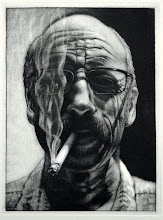Resolving the impressions may involve techniques and methods that don't require the press. Some of the images may be better resolved with some hand work, drawing and/or painting. Afterall, it is a monotype, a one-of-a-kind impression. Often called the "painterly" print medium. Troy's resolution to his "kind of a cross" image was to go additive rather than sustaining the reductive process, allowing him to expand his imagination. This process merges printmaking, drawing, and painting, and can often do so with rich and exciting works. After printing, the image can be reworked to some extent using various types of media. However, it's a good idea to think about what that media is, or will be, since you're working on a oil based surface. Don't lose the integrity of the print by using it as simply a base for drawing or painting, but rather exercise your creativity to effectively blend those approaches.
This project stretched over twelve days, more than adequate time to print three colors, four if needed. That length of time actually could have yielded a small series of impressions, like Daniel is starting to explore. However, I can fully understand the intimidation factor that comes with a first semester printmaking student who comes in to work and isn't quite sure if they know how to mix the inks, or pull an impression on the press. That's why technical journals are so important. Of course, if you have a technical journal with no technical notes, it's a tough road working in the shop during non-class hours. So let's see if we can get our journals up-to-date on what we've covered so that the shop starts to experience more frequent activity than just Monday and Wednesday afternoons.
See you in the shop.

2 comments:
I think you know where I feel mine is weakest Brian. When you mention the paint brush here Brian do you think I would be best adding to that area to add definition by the handle with a brush? I really like the way the rest of the print is turning out and I'm kind of afraid I'll lift off those areas if I run it through the press again. I'm thinking that may have possibilites. I don't know that I'll have it ready by Friday since you mentioned letting the ink rest a bit.
Given the textural surface of the image, Connie, I think going into it with an additive process, such as brush work, might call too much attention to itself. I think it might be a better option to allow is to cure and then do one more run of color, or black.
Post a Comment